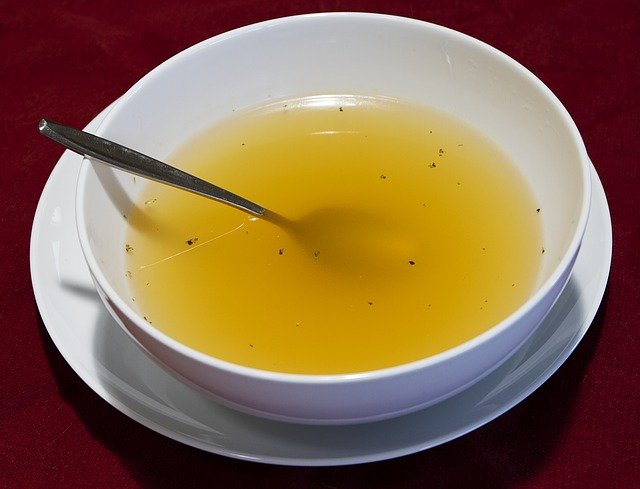Part 1 covered some alternatives if there are any issues breastfeeding. In Part 2 we’ll look at introducing solids.

Hopefully this isn’t the case all around the world, but in our western society, the prevalent (and inaccurate) belief that low fat is the healthiest way to eat has spread even to young children. So cereals are often recommended as a first food. But they can’t be digested till around 12 months, when sufficient of the enzymes needed to digest carbohydrates are produced.
Breast milk is high in fat, so your breastfed baby’s digestive system is used to digesting fat, and babies need a high level of dietary fat and cholesterol to promote healthy growth.
For all babies, it makes sense to introduce the foods that are easiest to digest first, but this is especially important for babies with allergies or digestive issues. First we’ll look at first foods for the healthy baby, then at foods for the sensitive baby. Whichever way you go (or pick and choose from both), introduce small amounts at a time, and keep feeding mostly breast milk or formula.
First foods for the healthy baby

According to the Weston A Price foundation, a rough rule of thumb of what to introduce when is:
4 months:
• egg yolks with a pinch of sea salt
• drops of cod liver oil
• mashed organic banana
6 months:
• pureed meats
• mashed or, in some cases, cooked fruit
• vegetables, cooked and mashed with butter or coconut oil
8 months:
• soups, stews and some dairy products
12 Months:
• properly prepared grains – How to prepare grains
• nut butters made from crispy nuts that have been soaked then dehydrated
• cooked leafy green vegetables
• raw salad vegetables
• citrus fruit
• whole egg.
You may be wondering why grains should be introduced at all, given the level of gluten or carb intolerance these days. If your baby is healthy, and their digestive system is sound, there is a window of opportunity around 12 months of age, when the right digestive enzymes start being produced. If properly prepared grains are introduced in small amounts at the right time, this will maximise your child’s chances of being able to handle grains later in life. Of course, if he or she shows signs of not being able to tolerate them, seek professional help.
For more information, see these helpful articles on the Weston A Price foundation website:
• More information on what to feed when, and how to prepare the foods for optimum digestion
• For what foods to offer after one year of age, see this article on tantalising foods for toddlers
• If your child is proving a picky eater, here are some useful techniques
First foods for the sensitive baby

These tips are from Dr Natasha Campbell-McBride, the author of Gut and Psychology Syndrome.
I have written about GAPS before, and you can learn more from these articles: About the Gut & Psychology syndrome (GAPS) diet Part 1 ~ GAPS diet Part 2: Foods we can’t have ~
GAPS diet Part 3: Foods we CAN have ~ GAPS diet Part 4: What if I can’t eat some animal foods
Dr Natasha recommends different starting points for bottle-fed and breastfed babies. For bottle-fed babies, start at 4 months. If your baby is breast fed and seems satisfied, you can wait till 6 months.
Each week, introduce 1-2 new foods. Start with 1-2 teaspoons of the new foods before giving the breast or bottle. Keep feeding the foods that have been successful from the previous weeks, and gradually increase the amounts.
Before introducing any food, do the skin test. At bedtime, take a drop of the food to test (mashed up with a little water if needed) in the form, cooked or raw, you intend feeding it. Put it on baby’s wrist and let it dry. In the morning check to see if there is any angry redness on the skin. If there is, avoid that food for a few weeks then try again. If there is no redness, this doesn’t necessarily mean the food is ok. You will still need to watch carefully for the results, observing bowel motions, skin conditions, mood or whatever your baby’s symptoms usually are.
The skin test won’t always pick up a sensitivity. So always start with tiny amounts and work up, noticing the results. If you notice any reaction, discontinue, wait a couple of days and test another food.
• Start with homemade chicken or meat stock (including the fat) - 1-2 tsp per meal. This is the most important food as it will help heal your baby’s digestive system. Chicken stock recipe
• Freshly pressed carrot juice, diluted with warm water and taken within 30 minutes – 1-2 tsp a day
• Add other veges to the fresh carrot juice eg cabbage, celery
• Add probiotic liquids to the stock. This can be homemade sauerkraut juice or fermented vegetable juice, or whey drained from homemade yoghurt. If the whey is well tolerated, you can try homemade yoghurt or fermented cream.
• Cook veges in the meat stock and puree with a little fat. Use non-starchy, peeled, seeded vegetables such as carrots, pumpkin, squashes, leeks, onions, garlic, broccoli, cauliflower or zucchini. Vary the fats. Safe fats to use are animal or poultry fats, butter, ghee, coconut oil, extra virgin olive oil. Gradually increase the thickness.
• Cod liver oil – best brands Green Pasture, NutraPro, Rosita – start with a drop or two
• Boiled meats and fish can be added to the soups. Include the skin and fattier bits.
• Ripe avocado can be mashed and added to soups
• Introduce or increase homemade yoghurt or fermented cream
• Add raw, pastured egg yolk to the soups
• Add ripe apple that has been cooked with plenty of ghee, coconut oil, or butter and pureed
• Add the yogurt or sour cream to the fresh pressed juices or water in a bottle.
• Increase the well-cooked, gelatinous meats
• Stop formula feeding (if breastfeeding, continue topping up after eating)
• Nut butter pancakes (made with almond or hazelnut nutbutter, squash, and eggs) – Recipe here
• Increase fresh juices and try adding apple to the juicing mix
• Add raw lettuce & peeled cucumber (blended & added to veggie soups/purees)
• After these two veggies are tolerated well you can slowly add other veggies, prepared in the same way — carrot, celery, cabbage, bell pepper, kohlrabi, etc.
• Try egg scrambled in plenty of good fat (see list above). Cook the egg gently, serving just a tiny bit, and serving with avocado or veggies.
• Add peeled, raw apple (as a between meal snack)
• Add ripe banana (between meals, make sure there are brown spots on the skin!)
• Add homemade cottage cheese made with your homemade yogurt.
• Add GAPS friendly bread – eg. my Grain free, dairy free Pumpkin & Cashew Bread
• Add small amounts of natural salt
Your baby will now be close to the full GAPS diet. Note that this doesn’t include any gluten, starches or unfermented dairy, as they are too difficult for a child with poor digestion to handle. In time, the diet is designed to repair the digestive system, so more foods can be eaten,
This is a overview of the order to add new foods – for more information on preparing each food, see Dr Natasha’s website.

Thanks for reading
Photos by myself, @sift666 or from Pixabay, unless otherwise stated.
Follow me for more health, nutrition, food, lifestyle and recipe posts.

